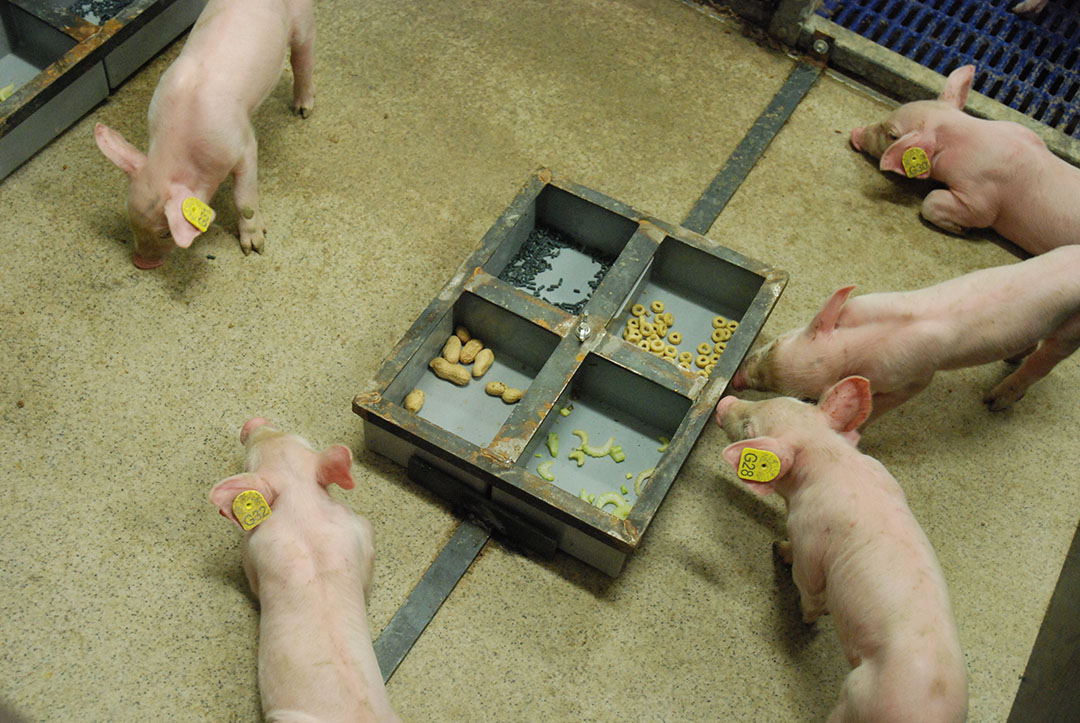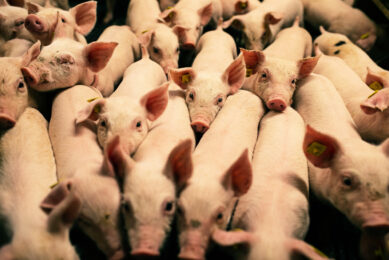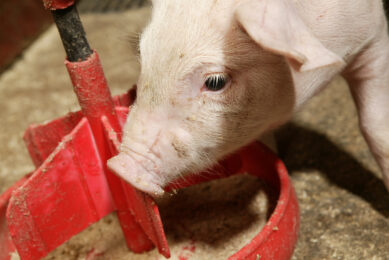Piglet feeding is about similarity and diversity

Anouschka Middelkoop, Researcher Swine Nutrition at Schothorst Feed Research in the Netherlands, explains in detail how similarity and novelty in piglet feed can play a big part in weaning piglets successfully.
Why does piglet feed play such a big part in weaning in your opinion?
“A lot of changes occur at weaning, and therefore you should try to keep as many factors as stable as possible. If you buy pigs at weaning and try to improve your weaner pigs performance, it is highly recommended to familiarise yourself with the management history of the pigs before they arrive on your farm. A delayed and low feed intake plays, together with stress, a large role in the gut health problems seen after weaning. It is therefore important to stimulate feed intake timely and to increase the number of eaters before weaning. The success of providing solid feed before weaning stands or falls with the similarity of the diet pre- and post-weaning. Schothorst Feed Research (SFR) therefore recommends a transition diet around weaning, in which the same diet is given at least in the last week before weaning and one week after weaning. Moreover, milk supplements and creep feed formulation can already focus on preparing a piglet’s gut for weaning.”
Do piglets recognise different flavours and are there flavours and aromas that clearly steer piglets?
“Yes, feed intake in pigs is very much focused on taste. Pigs have a high number of taste buds, which are located throughout the whole oral cavity. This allows them to taste even small differences in diets. Pigs have an innate preference for sweet, umami and sour taste. Simple carbohydrates, like sugars, stimulate sweet taste in pigs, thereby enhancing their voluntary feed intake. Umami taste can be triggered by several amino acids such as glutamine, alanine and arginine. In human diets, umami taste is elicited by cheese for example. Less research has been done on sour feedstuffs compared to sweet and umami. Piglets also recognise flavours that have been fed to their mother during late gestation (via amniotic fluid and foetal blood) and lactation (via milk and the smell inside the mouth of the sow). In terms of aromas, so far mostly synthetic aromas have been studied, such as vanilla, fruity aromas and anise, which have shown to attract pigs’ interest and stimulate pigs’ voluntary feed intake. However, a study in fattening pigs by Polish researchers indicates that pigs showed more interest in enrichment with natural aromas, such as from grass, moist soil and dried mushrooms, rather than enrichment with synthetic vanilla, orange and strawberry aromas.”
One of your research papers talks about providing novel feed items to piglets, why did you carry out this research?
“This particular study was part of my PhD at Wageningen University in which I aimed to find strategies to stimulate solid feed intake by piglets before weaning. To do so, we aimed to learn from nature and apply aspects from nature into indoor pig production. Under natural conditions, piglets consume a wide variety of feed items, already from a young age. They have been seen consuming feed items such as acorns, corn, insects, mushrooms, leaves and roots. You can also look at this from a human perspective. Imagine that you are going to a restaurant and there is a buffet. At some point, you have had enough of the steak and fries, but still want some chocolate cake for dessert. This is called ‘sensory-specific satiety’, which is a decline in the liking of eaten food in comparison to non-eaten food. Dietary diversity has shown to increase feed intake in humans, rats and our hypothesis was that it would also be applicable for pigs.”
How did the piglets react to ‘novel’ feeds? Did they develop preferences?
“In this ‘extreme’ dietary diversity experiment we provided peanuts in shell, celery (pieces), cereal honey loops and experimental creep feed to the piglets. The feed items were chosen as such to create a diet as diverse as possible in terms of sensory properties, meaning sweet and bitter taste, small and large items, hard and soft structures etc. Surprisingly, creep feed was least preferred of all four items, which means we can still improve a lot in the presentation of the feed to young piglets to make it more appealing for them. Since piglets still need to develop their motor skills and learn how to eat before weaning, feed presentation is expected to be of utmost importance. Some piglets developed strong feed preferences for one or more feed items, while others divided their eating time equally over the four items. Strong feed preferences were also observed between litters. Most piglets (86%) within the litters fed a diverse diet were seen eating all four items, suggesting that piglets like to have choice!”
Were there differences in zootechnical performance in the piglets which were given the diverse diet?
“Dietary diversity elicited play behaviour with the feed, increased solid feed intake to a great extent and resulted in all piglets to consume solid feed before weaning. On top of that, piglets fed with the diverse diet had a higher body weight gain in the last two days before weaning than piglets fed the monotonous diet (280 vs. 251 g/day). After weaning, all piglets were fed a standard weaner diet, which was different in composition from the creep feed that was given. Piglets that were given a diverse diet before weaning tended to have a worse feed conversation ratio in the first 2 weeks post-weaning than piglets that were given creep feed before weaning. No other effects on weaner pig performance were reported. Effects on post-weaning feed intake were expected due to the high pre-weaning feed intake and number of eaters. One of the reasons that the beneficial effects of dietary diversity on post-weaning performance might have been minor, is that piglets fed a diverse diet seemed to like the creep feed the least compared to the other three feed items. Piglets fed a diverse diet mainly ingested the other feed items, which connected less well to the weaner diet in terms of structure and ingredient composition. The latter may also explain the trend for a higher feed conversion ratio. This shows again the importance of the interaction between the composition of the pre- and post-weaning diet in the successfulness of post-weaning performance.”

What is your opinion on piglet feeding with a diverse diet instead of a standard piglet feed and what affect do you think this has on a developing piglet’s gut, immunity and other weaning challenges?
“I see a particular role for dietary variety in pig production in those phases in which feed intake can be stimulated to improve pig health and welfare. During my PhD I tested dietary variety as means to stimulate solid feed intake in suckling piglets, but other applications may be used in weaned pigs to reduce weaning anorexia, or for sows to stimulate feed intake. At weaning, anorexia has a considerable negative effect on piglet gut health, so a smoother feed intake pattern after weaning would be preferable. Feeding a diverse diet also allows pigs to eat according to their wishes and needs, which can be different for piglets within a group. Moreover, a diverse diet has shown to increase the number of eaters before weaning and several studies have shown that eaters have improved gut development and performance.”






